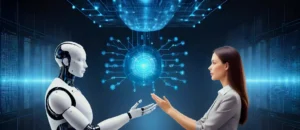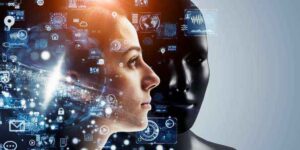Introduction
Natural Language Processing (NLP) and Artificial Intelligence (AI) have fundamentally reshaped the way humans interact with machines. As we witness rapid technological advancements, these fields are increasingly converging, creating more seamless, accurate, and intuitive communication methods between humans and machines. This article explores how the merging of NLP and AI is enhancing human-machine communication, its applications, and the potential it holds for the future.
Understanding NLP and AI: Core Concepts
To appreciate the convergence of NLP and AI, it’s essential to understand each field individually.
What is Natural Language Processing (NLP)?
Natural Language Processing (NLP) is a branch of computer science and AI that focuses on enabling machines to understand, interpret, and generate human language. Unlike programming languages, human languages are complex and filled with nuances, idioms, and emotions. NLP uses algorithms and computational models to analyze this language, breaking it down to enable machines to understand and respond meaningfully.
NLP involves several components, including:
- Syntax Analysis: Understanding sentence structure.
- Semantic Analysis: Deriving meaning from text.
- Pragmatic Analysis: Contextual interpretation.
- Sentiment Analysis: Identifying the emotion behind the text.
These components collectively allow machines to process text and respond accurately to human input.
What is Artificial Intelligence (AI)?
Artificial Intelligence (AI) encompasses a range of technologies that enable machines to perform tasks that would typically require human intelligence. AI systems can perceive their environment, make decisions, solve problems, and even learn from experience. There are two primary types of AI:
- Narrow AI: Designed to perform a specific task, such as language translation.
- General AI: Hypothetical AI that could theoretically perform any intellectual task a human can.
AI utilizes various approaches, such as machine learning, deep learning, and neural networks, to replicate human-like intelligence and decision-making.
The Role of AI in Advancing NLP
NLP and AI have always been closely linked, but recent advances in AI have significantly boosted NLP capabilities. Here’s how AI advancements are accelerating NLP:

Machine Learning and Deep Learning
Machine learning (ML) and deep learning (DL) algorithms are the backbone of modern NLP applications. ML involves training algorithms on large datasets to improve their accuracy in specific tasks, such as translation or sentiment analysis. Deep learning, a subset of ML, uses neural networks with multiple layers (deep neural networks) that mimic the human brain’s structure, allowing machines to identify complex patterns and nuances in text and speech.
With deep learning, NLP systems can now understand context, sarcasm, and even humor, providing more nuanced responses. For instance, models like GPT-3 and BERT have been developed using deep learning to provide accurate, context-aware responses, making conversations with machines feel more natural.
Improved Language Models
AI has given rise to sophisticated language models capable of processing and generating human-like text. OpenAI’s GPT series and Google’s BERT are prime examples. These models are pre-trained on massive datasets, allowing them to predict and generate text based on input patterns, context, and semantics.
Through transfer learning, these models can quickly adapt to specific tasks with minimal additional data. This capability has revolutionized NLP applications, from chatbots to virtual assistants, by improving their ability to understand and engage in complex conversations.
Applications of NLP and AI Convergence
The integration of NLP and AI has opened doors to numerous applications, enhancing communication across various industries. Here are some of the most impactful applications:
1. Chatbots and Virtual Assistants
Chatbots and virtual assistants, like Siri, Alexa, and Google Assistant, have become commonplace in homes and workplaces. Through NLP and AI, these systems can understand user commands, answer questions, and perform tasks. NLP enables them to interpret user input accurately, while AI allows them to learn from interactions and improve over time.
In customer service, AI-driven chatbots are revolutionizing user experiences by providing instant support, resolving common queries, and even handling complaints, allowing human agents to focus on complex issues.
2. Translation Services
Language translation has been one of the most significant achievements in NLP. Tools like Google Translate use AI-powered NLP to provide accurate translations across hundreds of languages. AI’s neural machine translation models consider context, idioms, and nuances, delivering natural translations that go beyond word-for-word interpretation.
This capability has proven invaluable for businesses expanding globally, travelers, and people communicating across language barriers.
3. Sentiment Analysis in Social Media Monitoring
Sentiment analysis allows businesses to understand customer opinions and emotions by analyzing text data from social media, product reviews, and other user-generated content. By using NLP algorithms, companies can gauge public sentiment on their brand, products, or services and make data-driven decisions.
AI enhances sentiment analysis by detecting sarcasm, irony, and other nuanced tones that are difficult for traditional NLP systems to interpret. This insight enables brands to respond promptly to customer feedback and adjust their strategies based on real-time sentiment analysis.
4. Healthcare Diagnosis and Assistance
In healthcare, NLP and AI are transforming patient care and diagnostics. Medical records, patient notes, and research papers contain valuable information that NLP-powered AI systems can analyze to aid diagnosis and treatment. For instance, IBM’s Watson Health uses NLP to scan medical literature and suggest treatment options based on a patient’s history and symptoms.
These systems can also serve as conversational agents, assisting patients with routine inquiries and offering preliminary guidance, reducing the workload on healthcare professionals.
5. Content Generation and Recommendation
NLP-powered AI systems are becoming invaluable in the media and content industry. Content generation tools, such as OpenAI’s GPT, help create blog posts, marketing copy, and even complex research reports. With minimal human intervention, these systems can generate coherent, high-quality content, saving time for writers and marketers.
Recommendation engines, like those used by Netflix, Amazon, and Spotify, rely on NLP to analyze user preferences and recommend relevant content. These engines consider users’ past interactions, preferences, and even review sentiments to personalize recommendations, enhancing user engagement.
Challenges in Merging NLP and AI
While the convergence of NLP and AI offers remarkable benefits, it also presents challenges:

Data Privacy and Security
Handling large amounts of personal data for AI-driven NLP applications raises privacy concerns. Sensitive information, like conversations with virtual assistants or patient data in healthcare, needs to be protected from misuse and breaches. Strict privacy protocols are essential to build trust and safeguard user data.
Bias in AI Models
AI models often inherit biases present in their training data. This can result in biased or inappropriate responses, especially in sensitive applications like hiring or legal assistance. Addressing and minimizing these biases is crucial to ensure fairness and accuracy in NLP-driven AI systems.
Complexity of Human Language
Despite significant advancements, NLP models still struggle with the complexity of human language. Understanding slang, cultural references, emotions, and dialects remains challenging. Improving these aspects will require ongoing research and innovation.
The Future of NLP and AI Convergence
The future of NLP and AI promises exciting advancements, as researchers continue to push the boundaries of human-machine communication.
Increased Contextual Understanding
Future NLP models will likely improve in contextual understanding, making them more adept at handling complex conversations, interpreting emotions, and responding empathetically. This will enhance the capabilities of virtual assistants, making them more relatable and engaging.
Multi-Modal Communication
As AI advances, we may see NLP systems that integrate other forms of communication, like facial expressions, tone of voice, and gestures. This multi-modal approach will provide a richer understanding of user input, enabling machines to respond in a more human-like manner.
Real-Time, Cross-Language Interaction
Real-time cross-language communication will make interactions with people from diverse linguistic backgrounds smoother and more effective. This could have profound implications for business, travel, and even diplomacy, breaking down language barriers and fostering global connections.
Conclusion
The convergence of NLP and AI is creating a future where human-machine communication is increasingly natural, efficient, and intuitive. From virtual assistants and chatbots to healthcare diagnostics, sentiment analysis, and even the NLP used in healthcare to enhance patient care, the applications of this convergence are already shaping how we interact with technology daily. As challenges such as data privacy, bias, and language complexity are addressed, the potential of NLP and AI to revolutionize human-machine communication continues to grow, promising a more connected and accessible world.
If you found this article insightful and would like to stay updated on the latest trends in AI, NLP, and emerging technologies, feel free to connect with me on LinkedIn. Let’s engage in meaningful discussions, share ideas, and collaborate on future projects.
